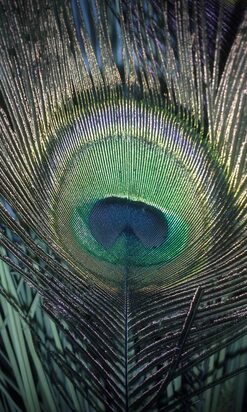Peacocks are one of the many types of poultry that we have on our farm. They make all kinds of crazy noises, but also add a lot of beauty to the farm.

The Peafowl is a type of poultry from the family Phasianidae. These are the birds with the beautiful iridescent blue and green feathers. Many people call the entire species ‘Peacocks’, but the reality is, only the males are Peacocks, the females are called ‘Peahens’ and the chicks are called ‘Peachicks’ or just chicks.
Adults weigh 9-13lbs and can eat a varied diet of plant leaves, flowers, seeds and various insects. In captivity, they are usually fed a commercially available game bird ration that is suitable for turkeys. Newly hatched Peachicks need a 30% protein starter. Once the birds are 4-5 weeks old, they can be transitioned to a 26% grower ration. Adults can be fed a variety of different grains; however, if good breeding is desired, it’s advisable to feed them a well balanced game bird breeder ration, starting one month prior to the planned breeding season.

Yearling male Blue India
Sounds
Peacocks make very shrill noises, particularly during mating season. For Peacock breeders, this is usually not an annoyance, but some more populated areas might not allow Peacocks because of the noise.
One of their common noises almost sounds like the bird is calling 'Help!'. My family has raised Peacocks for many years and once had a neighbor run to our house thinking one of the kids had been injured. The noise was just the Peacock.
Housing
In the wild, Peafowl prefer to spend time in low brush and roost in trees at night. Even though they are a large bird, they fly fairly well. To keep Peafowl in captivity, a strong pen that is 20’x10’ with 7’ tall sides is ideal for a trio. When a Peacock is full grown, his tail could end up being 8’ wide and up to 6’ tall, so he needs lots of space.
The Tail
A male Peafowl will take three years to fully grow his tail. He will then molt his tail annually. This allows us to collect those beautiful feathers for decorative use. We use the term tail to describe the huge fan of feathers that the male peacock has; however, he actually only has about 20 true tail feathers (known as retrices). The beautiful feathers are actually tail coverts. The average peacock has over 100 tail coverts. The large ‘tail’ is better known as a ‘train’ in the peacock world.
The train is for courtship, and a Peacock will only fan his tail when he feels like it. He won’t do it on command as much as humans might wish he would.
The Species
The name Peafowl includes two Asiatic species, the Indian Blue, and the Green. There is also one African Species, the Congo Peacock. The various species are native to India, Burma, Java, Ceylon, Malaya and Congo.
Breeding
Only healthy birds with good colour, and excellent feet and legs should be used for breeding. Some Peafowl have crooked toes. These should not be used for breeding.
One Peacock can be mated to up to five hens. It’s ideal to have two or more hens with each Peacock.

Black Shouldered Peacock and his hen.
Hatching
Sometimes a Peahen will lay 6-10 eggs then sit on them. This isn’t a very reliable way of hatching eggs, because if the hen is scared, she will probably leave her nest and not come back.
Artificial incubators are a good way to hatch fertile eggs. To insure the best chance to hatching, don’t put more than 5 Peahens with one Peacock. Keep the birds well fed and in a clean, comfortable environment. Collect the eggs daily and store them in a cool, but not cold place (50-60 degrees is ideal) for a maximum of 7 days. Either turn the eggs daily, or place them in a carton with one end elevated slightly, turn the carton so the other end is elevated once per day.
Peafowl eggs should be incubated at the same temperature as turkeys. An exact temperature is not listed here because different incubator models may vary slightly. Check your incubator manual for information.
Peafowl will hatch after 28 days of incubation. As with other poultry, they should stay in the incubator for approximately 24hours. They will have enough nutrients from their egg yolk to last this long without food or water. They should be removed to a heated brooder that has a non-slip floor. Lining the floor with a material like burlap can help. Use a thermometer to check the temperature at the height of the chick’s back. The temperature should be 90-95 degrees for the first week, then reduced by 5 degrees each week after that. By 7-8 weeks, they will have all their feathers and won’t need heat. At this point, they can be moved to housing suitable for adult birds.
History
Peafowl are popular in ancient history. The Phonecians were supposedly the first group to import the birds when they brought Peafowl to the Pharoah’s in Egypt. King Solomon referred to Peacocks in a list of valuables, including gold and silver. Alexander the Great imported them to Greece in 300 B.C. Peafowl were recorded in France, Germany and England by the 14th century.
Peafowl were a symbol of immortality in the Middle Ages. Before going into battle, knights would say the ‘Vow of the Peacock’ with their hand extended over a roasted peacock. They would put a feather in their helmet to remember the vow.
Some countries have considered Peacocks sacred, others considered them a delicacy and served them as a sign of wealth.